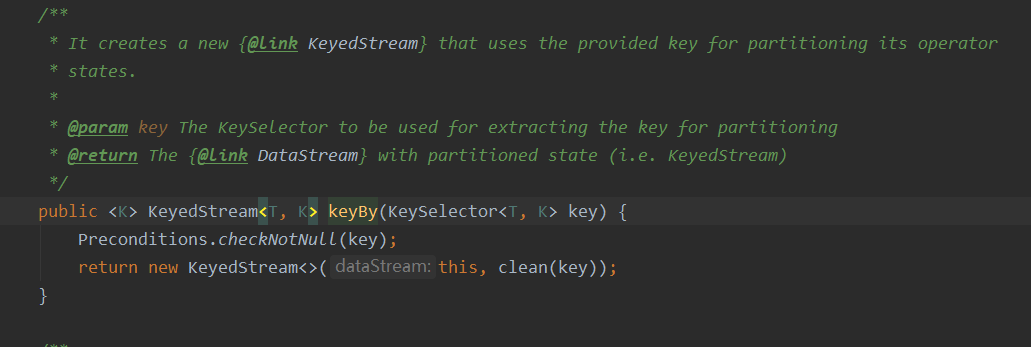聚合算子
我们往往需要对大量的数据进行统计或整合,从而提炼出更有用的 信息。比如要对每个词出现的频次进行叠加统计。这种操作,计算的结果不仅依赖当前数据,还跟之前的数据有关,相当于要把所有数据聚在一起进行汇总合并 ——这就是所谓的“聚合”(Aggregation),也对应着 MapReduce 中的 reduce 操作。
KeyBy
DataStream 是没有直接进行聚合的 API 的。因为我们对海量数据做聚合 肯定要进行分区并行处理,这样才能提高效率。所以在 Flink 中,要做聚合,需要先进行分区; 这个操作就是通过 keyBy 来完成的。

基于不同的 key,流中的数据将被分配到不同的分区中去,这样一来,所 有具有相同的 key 的数据,都将被发往同一个分区,那么下一步算子操作就将会在同一个 slot 中进行处理了。

简单聚合
有了按键分区的数据流 KeyedStream,我们就可以基于它进行聚合操作了。Flink 为我们 内置实现了一些最基本、最简单的聚合 API,主要有以下几种:
⚫ sum():在输入流上,对指定的字段做叠加求和的操作。
⚫ min():在输入流上,对指定的字段求最小值。
⚫ max():在输入流上,对指定的字段求最大值。
⚫ minBy():与 min()类似,在输入流上针对指定字段求最小值。不同的是,min()只计 算指定字段的最小值,其他字段会保留最初第一个数据的值;而 minBy()则会返回包 含字段最小值的整条数据。
⚫ maxBy():与 max()类似,在输入流上针对指定字段求最大值。两者区别与 min()/minBy()完全一致。
1 | package com.hlz.flink.chapter05; |
输出:
max: > Event{user=’Mary’, url=’./home’, timeStamp=1970-01-01 08:00:01.0}
max: > Event{user=’Bob’, url=’./cart’, timeStamp=1970-01-01 08:00:02.0}
max: > Event{user=’Alice’, url=’./prod?id=100’, timeStamp=1970-01-01 08:00:03.0}
max: > Event{user=’Bob’, url=’./cart’, timeStamp=1970-01-01 08:00:04.0}
max: > Event{user=’Bob’, url=’./cart’, timeStamp=1970-01-01 08:00:05.0}
max: > Event{user=’Bob’, url=’./cart’, timeStamp=1970-01-01 08:00:06.0}
max: > Event{user=’Mary’, url=’./home’, timeStamp=1970-01-01 08:00:07.0}
看红色这一条数据,第四条数据中的路径应该是/home,但是这里却是原来的/cart,说明max()只计 算指定字段的最小值,其他字段会保留最初第一个数据的。
把max()换成maxBy(), 结果输出如下:
maxBy: > Event{user=’Mary’, url=’./home’, timeStamp=1970-01-01 08:00:01.0}
maxBy: > Event{user=’Bob’, url=’./cart’, timeStamp=1970-01-01 08:00:02.0}
maxBy: > Event{user=’Alice’, url=’./prod?id=100’, timeStamp=1970-01-01 08:00:03.0}
maxBy: > Event{user=’Bob’, url=’./home’, timeStamp=1970-01-01 08:00:04.0}
maxBy: > Event{user=’Bob’, url=’./prod?id=9’, timeStamp=1970-01-01 08:00:05.0}
maxBy: > Event{user=’Bob’, url=’./prod?id=2’, timeStamp=1970-01-01 08:00:06.0}
maxBy: > Event{user=’Mary’, url=’./prod?id=3’, timeStamp=1970-01-01 08:00:07.0}
第四条数据已经中url变成了本身的数据了。
规约聚合
与简单聚合类似,reduce 操作也会将 KeyedStream 转换为 DataStream。它不会改变流的元 素数据类型,所以输出类型和输入类型是一样的。
调用 KeyedStream 的 reduce 方法时,需要传入一个参数,实现 ReduceFunction 接口, ReduceFunction 接口里需要实现 reduce()方法,这个方法接收两个输入事件,经过转换处 理之后输出一个相同类型的事件;所以,对于一组数据,我们可以先取两个进行合并,然后再 将合并的结果看作一个数据、再跟后面的数据合并,最终会将它“简化”成唯一的一个数据, 这也就是 reduce“归约”的含义。
我们将数据流按照用户 id 进行分区,然后用一个 reduce 算子实现 sum 的功能,统计每个 用户访问的频次;进而将所有统计结果分到一组,用另一个 reduce 算子实现 maxBy 的功能, 记录所有用户中访问频次最高的那个,也就是当前访问量最大的用户是谁。
1 | package com.hlz.flink.chapter05; |
输出:
reduceStream> (Mary,./mary,1)
reduceStream> (Bob,./hello,1)
reduceStream> (Alice,./prod,1)
reduceStream> (Alice,./prod2,2)
reduceStream> (Bob,./prod,2)
reduceStream> (Bob,./prod1,3)
reduceStream> (Bob,./prod2,4)
reduceStream> (Bob,./prod3,5)
reduceStream> (Bob,./prod3,5)
reduceStream> (Bob,./prod3,5)
reduceStream> (Alice,./prod2,5)
reduceStream> (Alice,./prod2,6)
reduceStream> (Alice,./prod2,7)
FAQ
在使用max操作的时候,报错Cannot reference field by field expression on GenericType<com.hlz.flink.chapter05.Event>Field expressions are only supported on POJO types, tuples, and case classes. (See the Flink documentation on what is considered a POJO.)

这是因为我们定义的Event对象不是标准的POJO对象,
标准的POJO类的要求:
所有成员变量都是私有的,用private修饰
每个成员变量都有对应的getter和setter
有一个无参的构造方法
我们Event没有无参构造,因此需要加上


